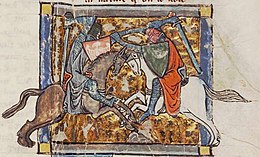
Back Ridderroman Afrikaans Höfischer Roman ALS رواية فروسية Arabic Рицарски роман Bulgarian Novel·la de cavalleries Catalan Rytířský román Czech Rhamant Welsh Ritterroman German Μυθιστορία Greek Kavalira libro Esperanto

| Literature | ||||||
|---|---|---|---|---|---|---|
 | ||||||
| Oral literature | ||||||
| Major written forms | ||||||
|
||||||
| Prose genres | ||||||
|
||||||
| Poetry genres | ||||||
|
||||||
| Dramatic genres | ||||||
| History | ||||||
| Lists and outlines | ||||||
| Theory and criticism | ||||||
|
| ||||||
As a literary genre, the chivalric romance is a type of prose and verse narrative that was popular in the noble courts of high medieval and early modern Europe. They were fantastic stories about marvel-filled adventures, often of a chivalric knight-errant portrayed as having heroic qualities, who goes on a quest. It developed further from the epics as time went on; in particular, "the emphasis on love and courtly manners distinguishes it from the chanson de geste and other kinds of epic, in which masculine military heroism predominates."[1]
Popular literature also drew on themes of romance, but with ironic, satiric, or burlesque intent. Romances reworked legends, fairy tales, and history to suit the readers' and hearers' tastes, but by c. 1600 they were out of fashion, and Miguel de Cervantes famously burlesqued them in his novel Don Quixote. Still, the modern image of "medieval" is more influenced by the romance than by any other medieval genre, and the word medieval evokes knights, damsels in distress, dragons, and other romantic tropes.[2]
Originally, romance literature was written in Old French (including Anglo-Norman), Old Occitan, and Early Franco-Provençal, and later in Old Portuguese, Old Spanish, Middle English, Old Italian (Sicilian poetry), and Middle High German. During the early 13th century, romances were increasingly written as prose. In later romances, particularly those of French origin, there is a marked tendency to emphasize themes of courtly love, such as faithfulness in adversity.
- ^ Chris Baldick (2008). "Chivalric Romance". The Oxford Dictionary of Literary Terms (3rd ed.). Oxford University Press. ISBN 978-0-19-172717-7. OCLC 4811919031.
- ^ Lewis, C. S. (1994). The Discarded Image (Canto ed.). Cambridge: Cambridge University Press. p. 9. ISBN 978-0-521-47735-2.